140th Anniversary – Cartoonist Dmitry Moor
November 3 (October 22) marked the 140th anniversary of the birth of the Soviet artist and graphic artist Dmitry Moor (1883-1946). His creative pseudonym Dmitry Stakhievich, who at first bore the ordinary surname Orlov, took in honor of the main character of Schiller’s “The Robbers”.
The artist greeted February 1917 as a supporter of the revolution, but at the same time he was by no means a Bolshevik. Here is a postcard based on his drawing, issued under the Provisional Government:
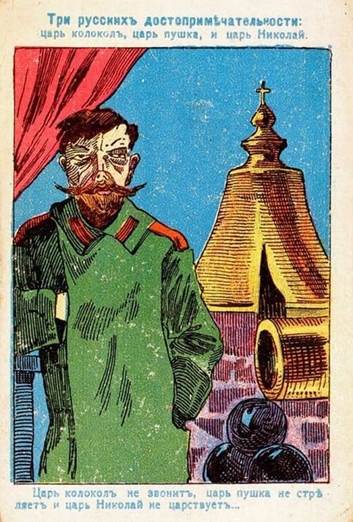
Postcard of 1917 after a drawing by D. Moore. “Three Russian landmarks: the Tsar Bell, the Tsar Cannon, and Tsar Nicholas. The Tsar does not ring the bell, the Tsar does not fire the cannon, and Tsar Nicholas does not reign…”
Another caricature by Moore of the abdication of Nicholas II:
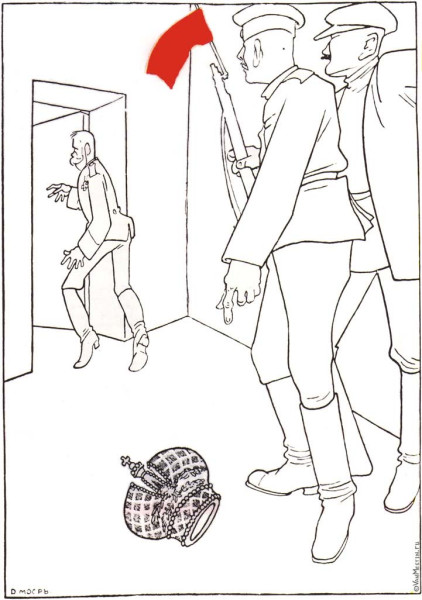
Drawing from 1917. “Citizen, take the crown too: Russia doesn’t need it anymore!” From the magazine “Lukomorye”, March 1917.
But at the same time, he was, as befits “any self-respecting honest intellectual,” an anti-Soviet (as were his colleagues, the future famous Soviet artists Viktor Denis, Boris Yefimov, Alexei Radakov, Konstantin Rotov, Boris Ioganson and others). Here is his typical drawing of this period, depicting Lenin and General Kaledin.
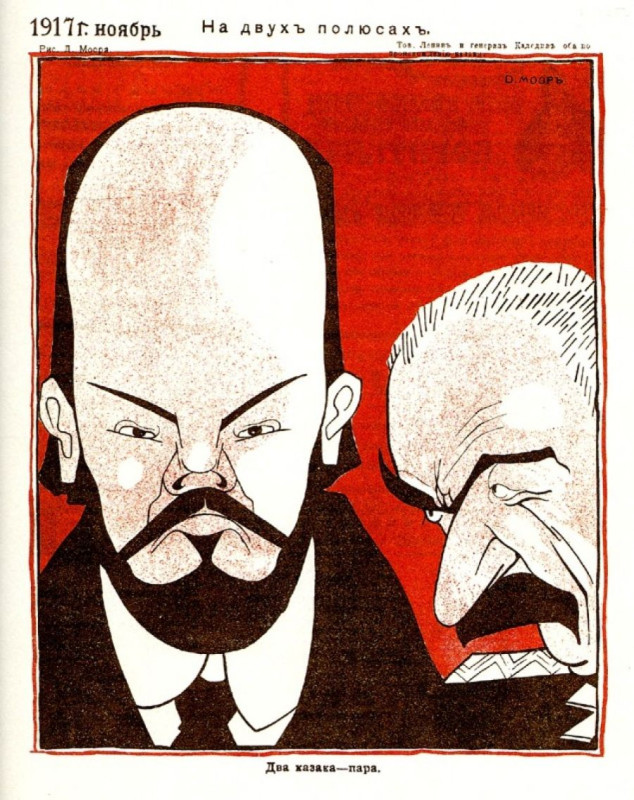
From the magazine “New Satyricon”. November 1917. “At two poles. Tov. Lenin and General Kaledin are both Cossacks by origin. Two Cossacks are a couple”
After the October Revolution, Moore, as at various times and all his brothers in the pen and brush mentioned above, nevertheless washed up on the Soviet shore. He became the author of many wonderful Soviet posters, the most famous of which, perhaps, is “Did you sign up as a volunteer?”, which was later used to make an innumerable number of remakes and photographs, as they would say now.
This is Moore’s most famous poster:
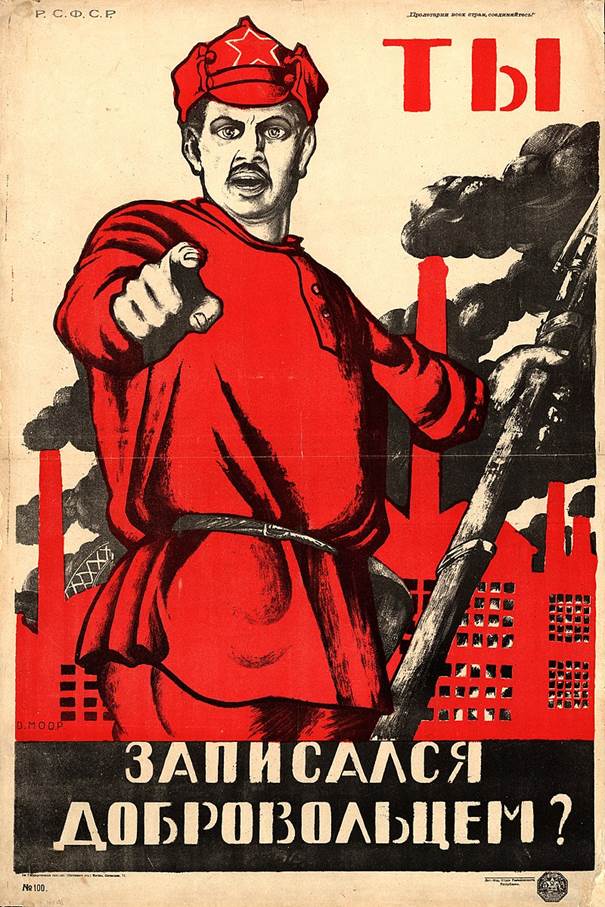
This is a similar poster of the White Guards:
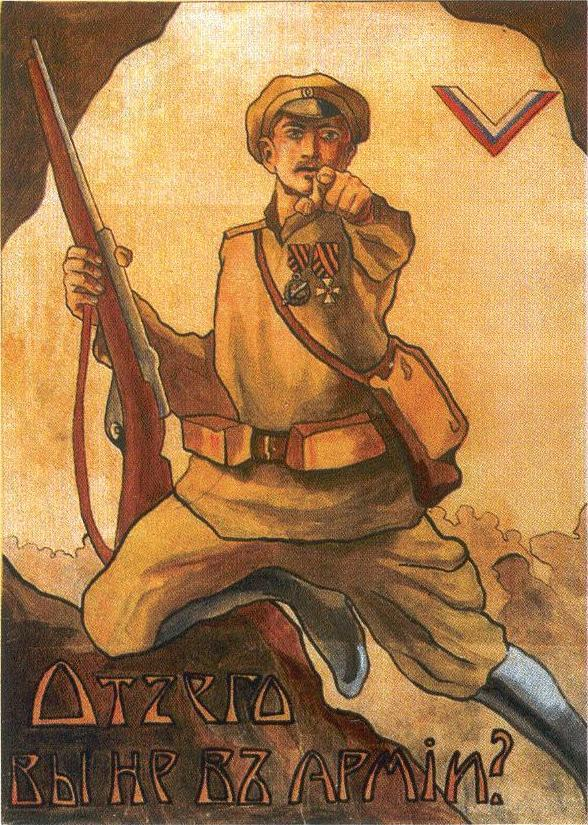
“Why Aren’t You in the Army?”, a poster of the White Army (Denikin)
Comparing the red poster with the white one, the well-known blogger and businessman Artemy Lebedev remarked: “It is difficult to get rid of the feeling that the whites lost the war only because of their designer’s helplessness – all their posters fade against the background of red agitation.” “Only because of designer helplessness” is, of course, a great conclusion, but it is also extremely characteristic of right-wing thinking. Or maybe the “designer’s helplessness”, as well as the other, were the result of some deeper causes? 🙂 But no, it can’t be, I guess I imagined… 🙂
Here is another, perhaps no less famous and no less replicated poster by Moor “Help”, dedicated to the famine in the Volga region in 1921:
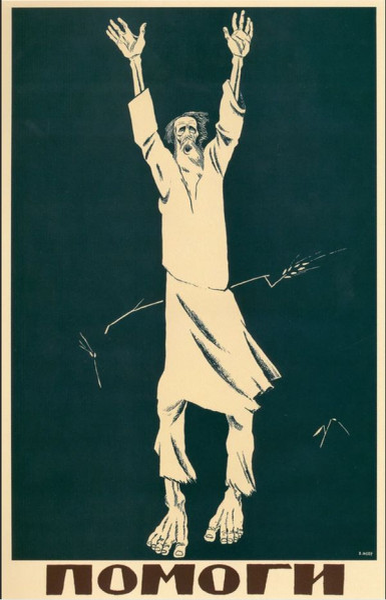
Dmitry Moor also created a bright gallery of caricatures of the leaders of the Bolsheviks and Soviet People’s Commissars. Anatoly Lunacharsky (1875-1933), People’s Commissar of Education of the RSFSR (1917-1929), fell under his sharp pen.
For example, this cartoon from 1922 ridicules the People’s Commissar’s excessive patronage of noble arts, such as ballet, in the artist’s opinion:
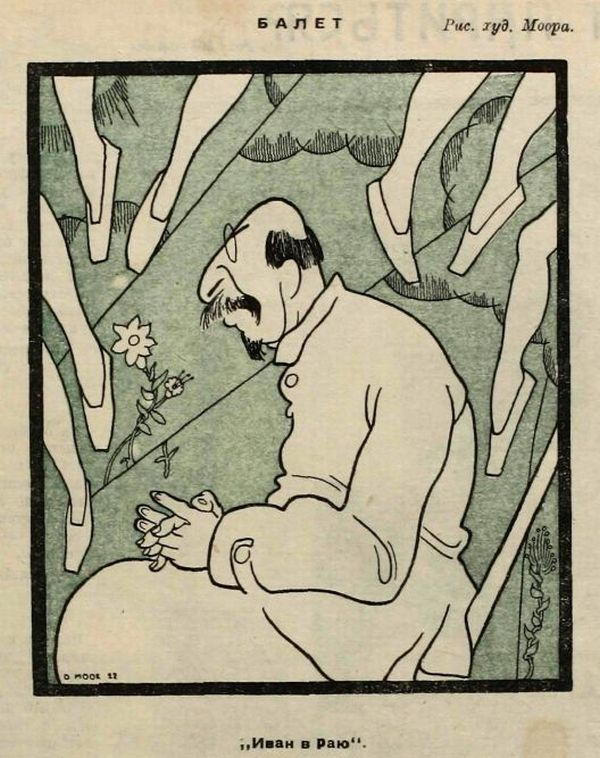
And why such a strange caption – “Ivan in paradise”? Because the People’s Commissar dabbled in writing plays, and one of them was called:
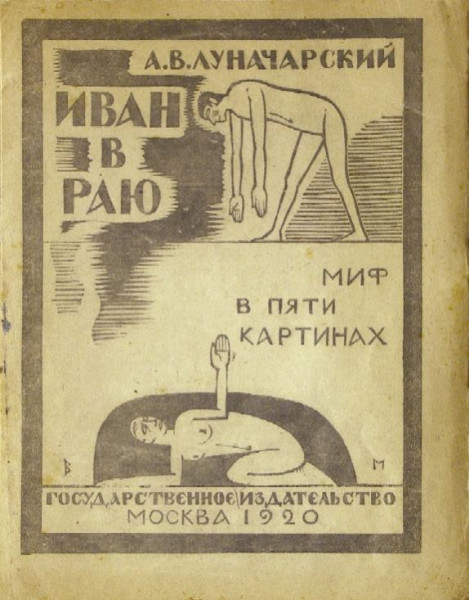
Another caricature of Lunacharsky by Moore:
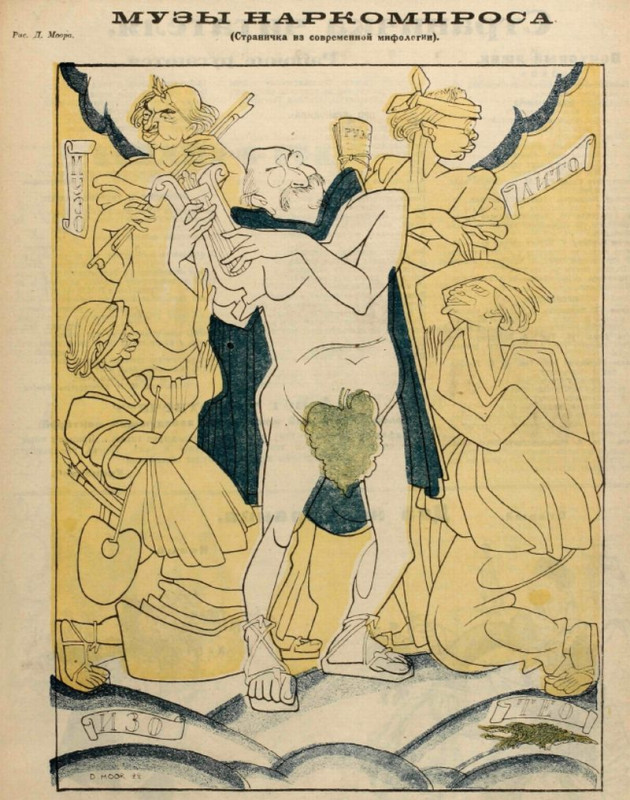
The year is 1922. “Muses of the People’s Commissariat for Education. A Page from Modern Mythology”. Theo, Lito, Izo, Muzo — departments of the People’s Commissariat for Education
Friendly caricatures of the People’s Commissar for Foreign Affairs Georgy Vasilyevich Chicherin (1872-1936).
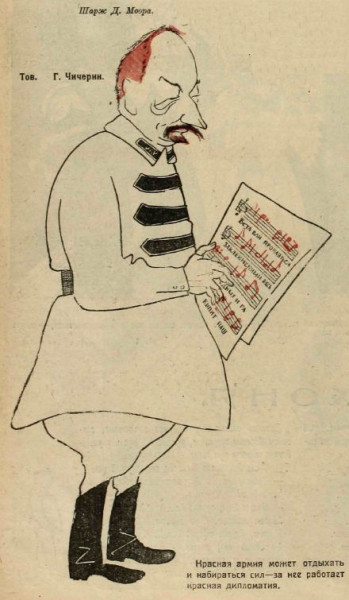
The year is 1922. “The Red Army Can Rest and Gather Strength – Red Diplomacy Works for It”
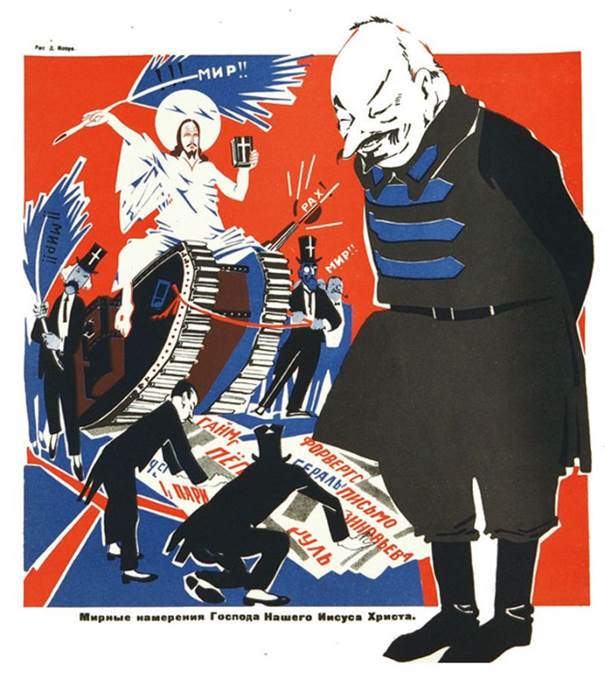
“The Peaceful Intentions of Our Lord Jesus Christ”
Nikolai Bukharin (1888-1938):
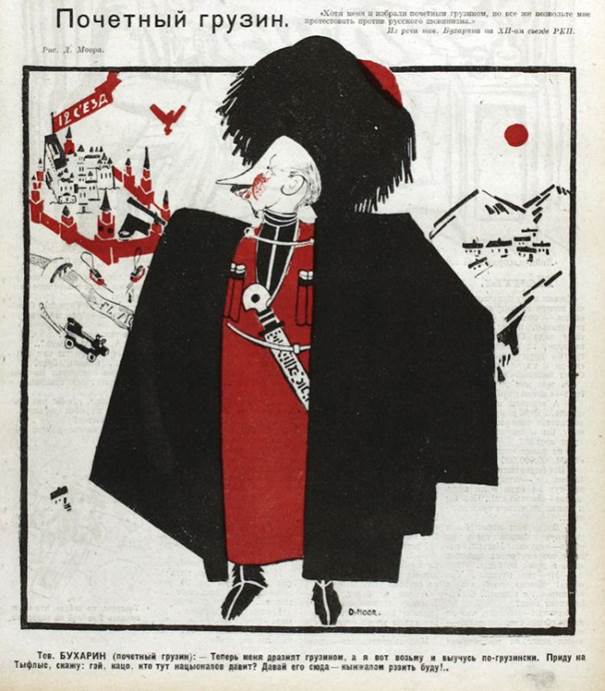
Drawing from 1923. Friendly caricature of N. Bukharin “Honorary Georgian”. “Although I have been elected an honorary Georgian, let me protest against Russian chauvinism.” From Comrade Bukharin’s speech at the Twelfth Congress of the R.C.P. “Comrade. BUKHARIN (honorary Georgian): “Now I am teased as a Georgian, but I will learn Georgian. I’ll come to Tyflys and say: hey, katso, who’s crushing the people here? Come here, I’ll cut him with a kynjal..”
On Joseph Stalin:
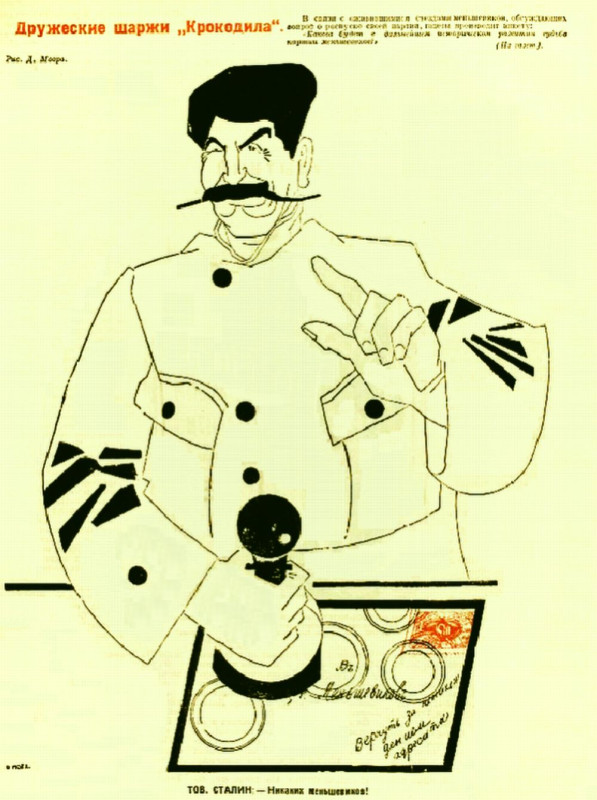
Friendly caricature of Joseph Stalin. Crocodile magazine, 1923. “In connection with the lively congresses of the Mensheviks, who are discussing the question of dissolving their Party, the newspapers are issuing a questionnaire: ‘What will be the fate of the Menshevik Party in further historical development?’ (From the newspapers).”
“Comrade. Stalin. “No Mensheviks!” (Stamps the envelope of the letter with the address: “To the Central Committee of the Mensheviks” and the resolution “Return for failure to find the addressee”).
On the “conscience of the party” by Aron Soltz (1872-1945):
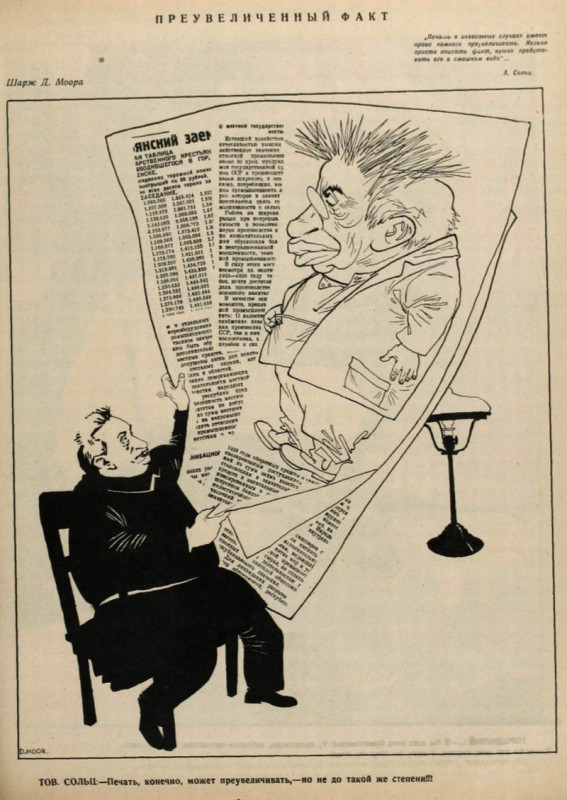
A caricature from 1927. “An exaggerated fact. In certain cases, the press has the right to exaggerate a little. You can’t just describe a fact, you have to present it in a funny way.” (A. Soltz). Tov. Soltz: “The press, of course, can exaggerate, but not to the same extent!!”
On Vladimir Ilyich Lenin:
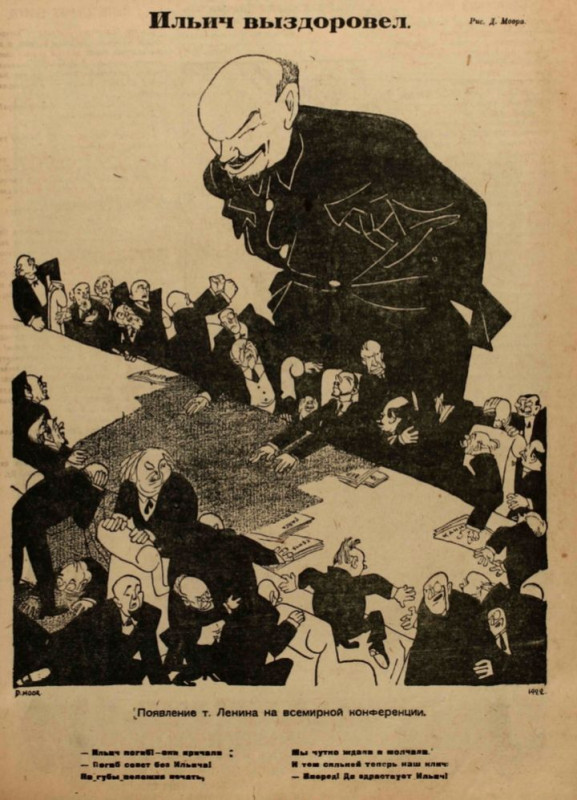
The year is 1922. “Ilyich recovered. Comrade Lenin’s Appearance at the World Conference
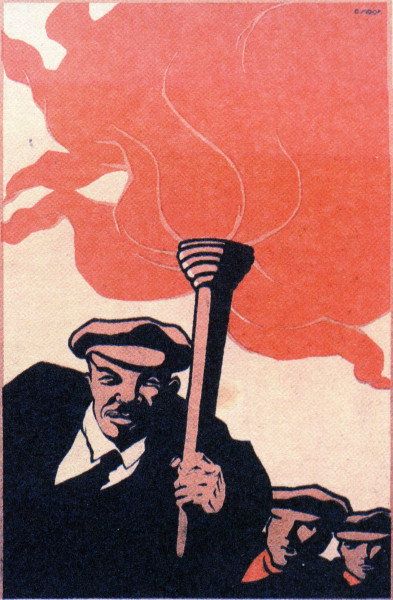
Lenin – the torchbearer of the world revolution
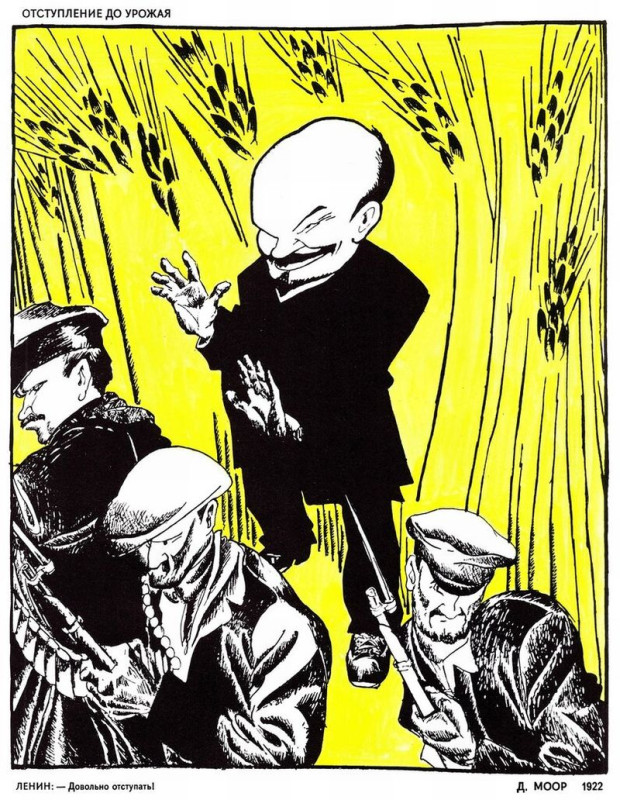
The year is 1922. “Retreat to the harvest. Lenin: “Enough of retreating!”
On Leon Trotsky:
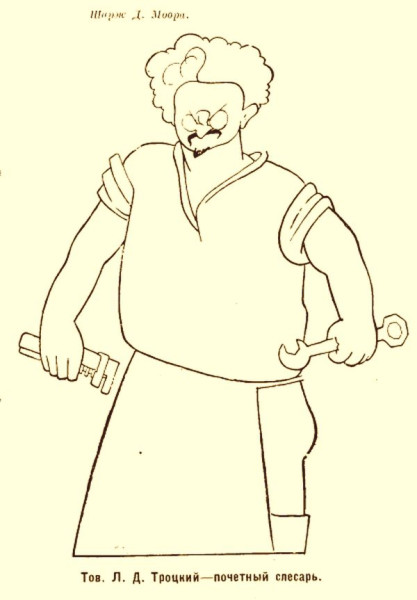
1923. “Honorary Locksmith”
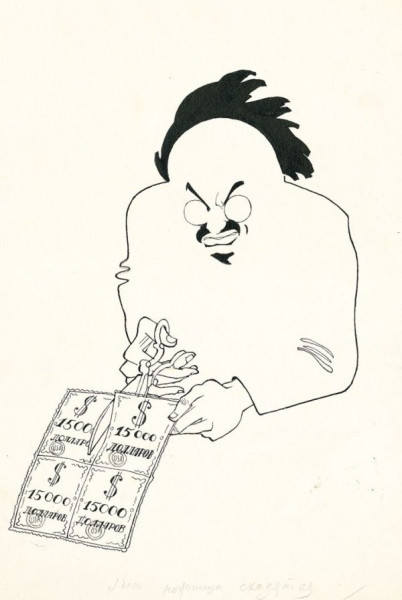
“This is where the scissors converge.” I am talking, of course, about the famous “price scissors” that were at the center of party discussions. The year 1924 was a time of critical, but still rather mild, caricatures of Trotsky
And this illustration depicts almost all the People’s Commissars at once:
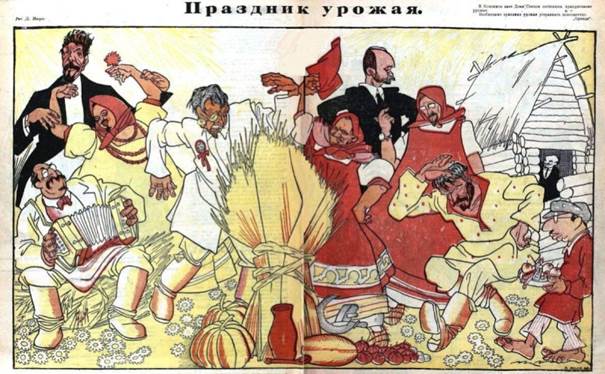
“Harvest Festival”. The year is 1922. Depicted (from left to right): Anatoly Lunacharsky (1875-1933) with an accordion, Alexei Rykov (1881-1938) in a black tailcoat, Grigory Sokolnikov (1888-1939) in a red handkerchief and a yellow sundress, Mikhail Kalinin (1875-1946) dancing in white clothes, Leonid Krasin (1870-1926) in a red scarf and sundress, Ivan Skvortsov-Stepanov (1870-1928) in a black jacket, Ivar Smilga (?) in a red sundress and pince-nez, Ivar Smilga (?) in a red sundress and pince-nez (1892-1937), in a yellow polka dot shirt — People’s Commissar of Agriculture Vasily Yakovenko (1889-1937), in a cap and with a tray of fruit — Deputy People’s Commissar Valerian Obolensky (1887-1938), looking out of the hut — V.I. Lenin.
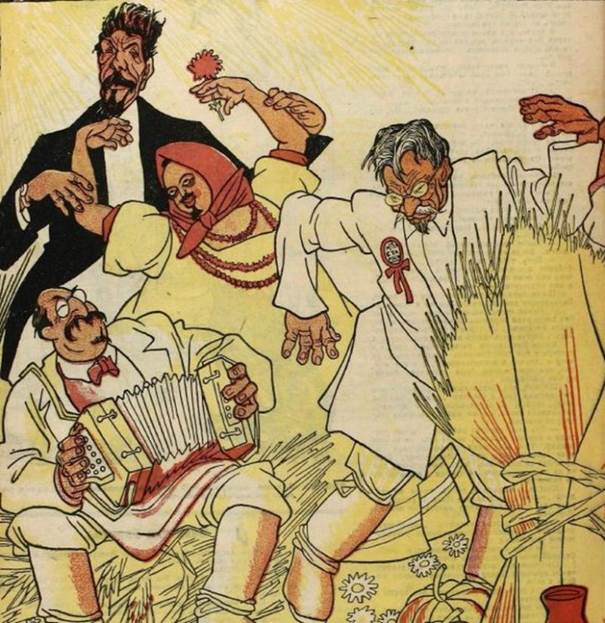
“Harvest Festival”. Fragment
And this caricature against Leon Trotsky dates back to 1929, when the leader of the Left Opposition, although he still retained Soviet citizenship, was exiled from the country to Constantinople:
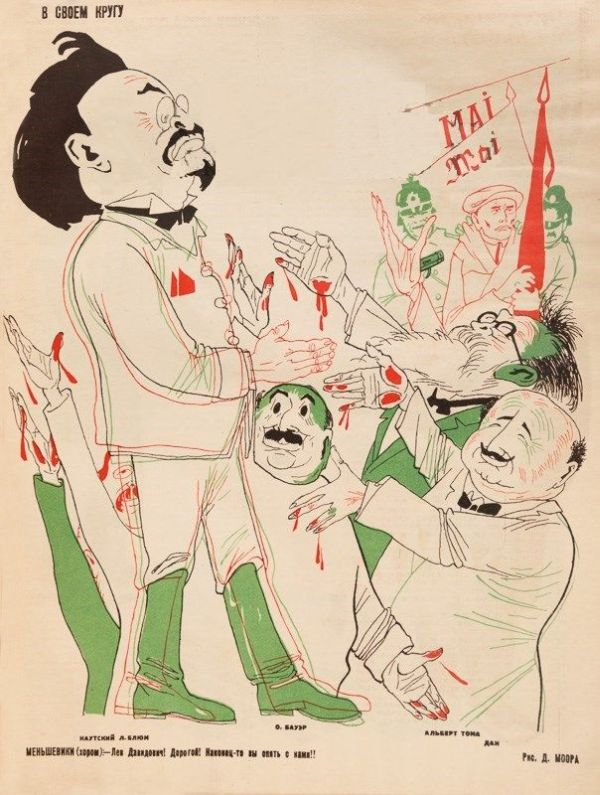
In the drawing, Trotsky was gleefully greeted by the blood-stained leaders of European and Russian Social-Democracy: the bearded Karl Kautsky, Leon Blum, Otto Bauer, Albert Thomas, Fyodor Dahn and others. In the background, the police arrest a worker with a red flag. Caption: “In my circle.
Mensheviks (in chorus). “Lev Davidovich!” My dear! You’re finally back with us!!”
Of course, Moore’s pen also affected the original opponents of the Bolsheviks. For example, the leader of the Mensheviks, Yuli Martov (1873-1923):
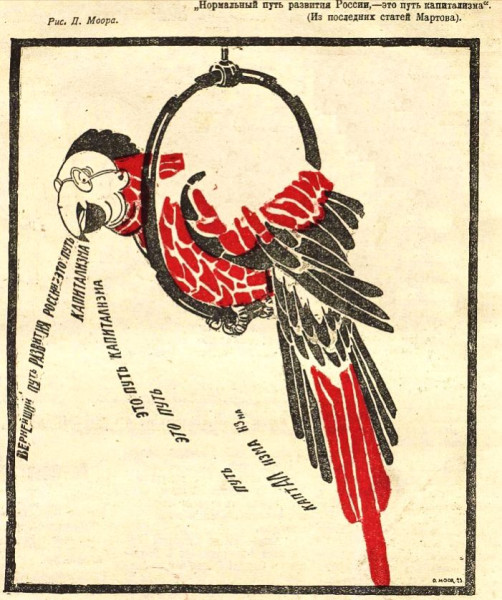
Caricature of the Menshevik leader Y. Martov. January 1923
Liberal leader Pavel Milyukov (1859-1943):
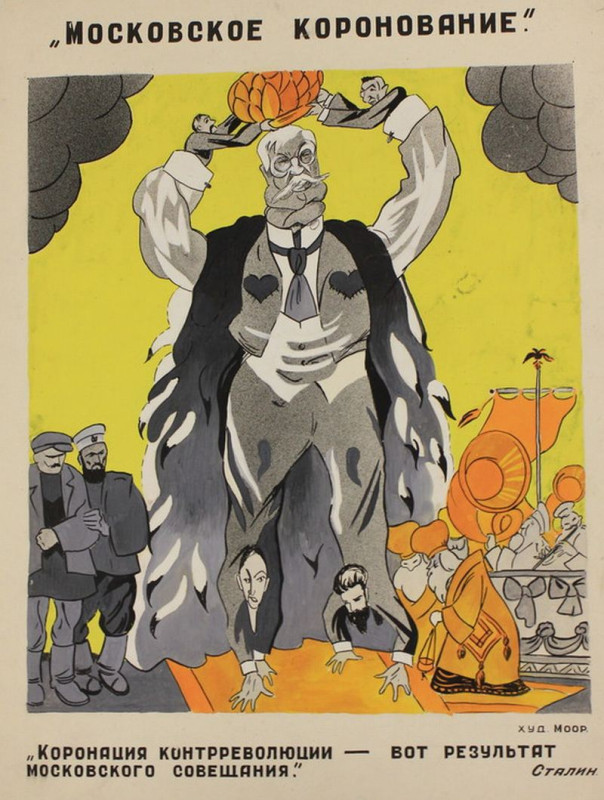
Dmitriy Moor, Irina Bek. Moscow Coronation. A caricature of General L.G. Kornilov, A.F. Kerensky and the leader of the Cadet Party P.N. Milyukov, on whom they place the crown. 1932
To the monarchist Black Hundred Nikolai Markov II (1866-1945):
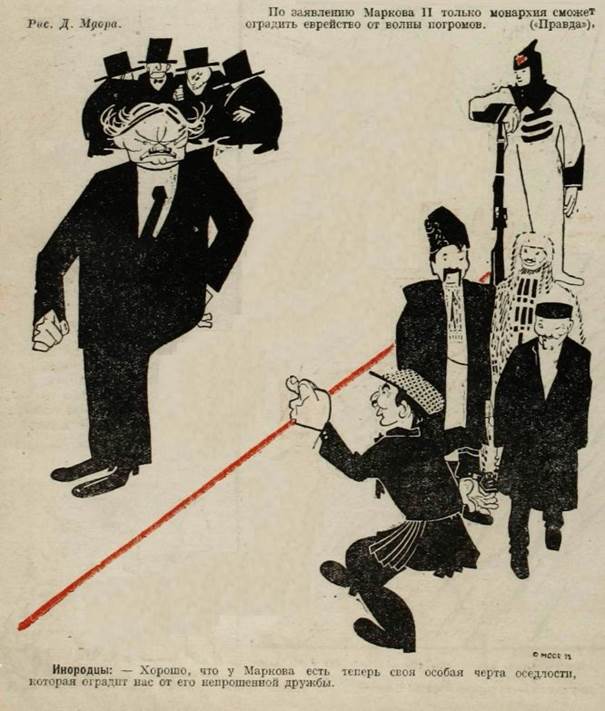
The year is 1922. “According to the statement of Markov II, only the monarchy will be able to protect Jewry from the wave of pogroms. (“The Truth”).” “It’s a good thing that Markov now has his own special Pale of Settlement, which will protect us from his unsolicited friendship.”
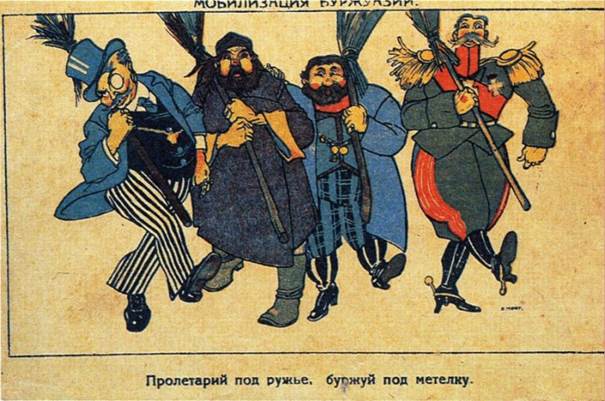
Postcard “Mobilization of the Bourgeoisie. The proletarian under arms, the bourgeois under the broom.”
This is a pair of arrows addressed to the theatrical and literary bohemia: Stanislavsky and Bulgakov.
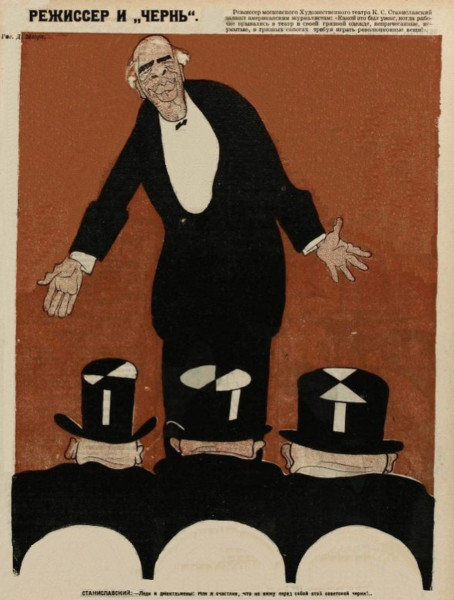
Drawing from 1923. “The director and the mob. The director of the Moscow Art Theater, K.S. Stanislavsky, told American journalists: “What a horror it was when the workers burst into the theater in their dirty clothes, uncombed, unwashed, in dirty boots, demanding to play revolutionary things!” Stanislavsky: “Ladies and gentlemen! How happy I am that I don’t see this Soviet mob in front of me..”
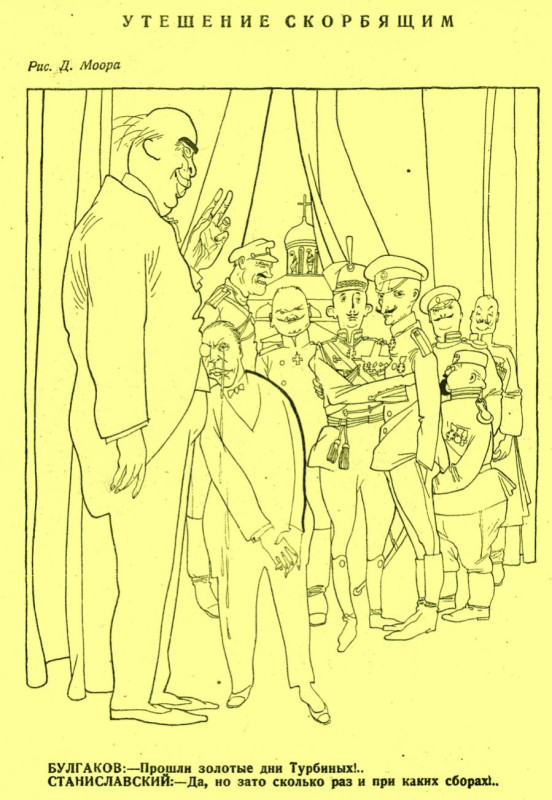
Caricature of M. Bulgakov, K. Stanislavsky and performers of the play “The Days of the Turbins” based on “The White Guard”. Year 1927
Bulgakov: The golden days of the Turbins are over..
Stanislavsky: “Yes, but how many times and at what training camps..”
A rather large place in Moore’s work was occupied by the “church” theme:
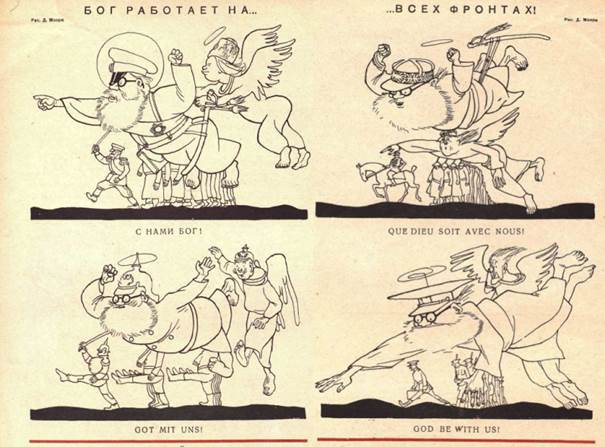
“God is at work on all fronts!” A 1934 drawing commemorating the 20th anniversary of the outbreak of the First World War
And this, by the way, is a curious parody drawing from 1925, which laughs at the style of four famous masters of Soviet caricature.
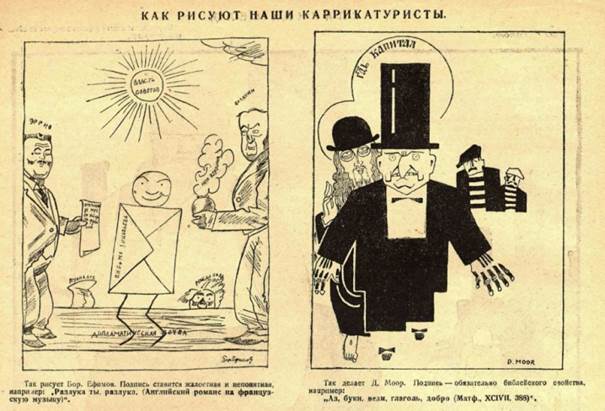
“This is how our caricaturists draw. That’s how Bohr paints. Efimov. The signature is pitiful and incomprehensible, for example: “Separation you, separation. (English Romance on French Music)”.
That’s what D. Moore does. The caption must be of a biblical nature, for example: “Az, buki, vedi, verb, dobro” (Matt., XCIVII, 388).”
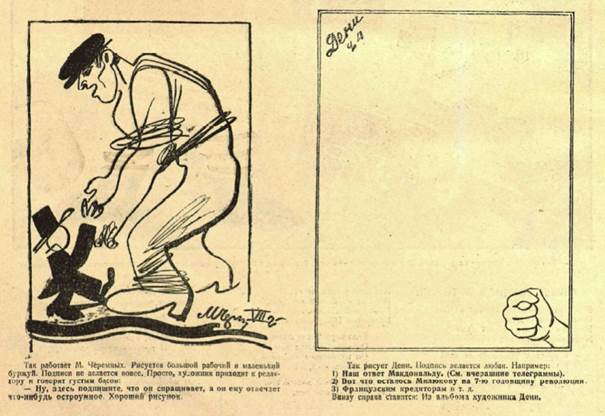
“This is how M. Cheremnykh works. A big worker and a small bourgeois are depicted. No signatures are made at all. Simply, the artist comes to the editor and says in a thick bass voice:
“Well, sign here that he asks, and he answers him with something witty.” Nice drawing.
That’s how Denis draws. Any signature can be made. For example:
1) Our response to MacDonald. (See yesterday’s telegrams.)
2) That is what was left for Milyukov on the seventh anniversary of the revolution.
(3) French creditors, etc.
